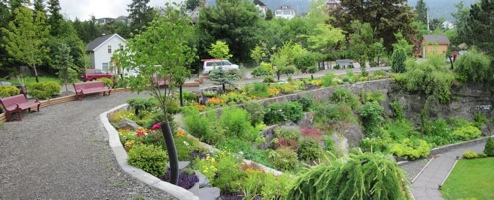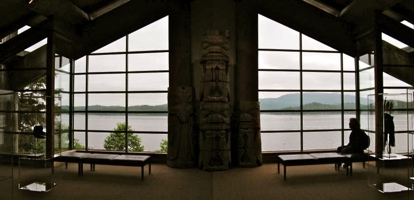 |
My solitary ramble around Prince Rupert was a pleasure. For a start, it wasn't raining :-) Watery sunlight persisted for most of the afternoon. On my way downtown I passed an intriguing sign identiifying the "Sunken Garden", and following it I found this car planter by the entrance to a pedestrian tunnel. I rather like car planters (as an habitual cycle/pedestrian advocate) and thought it might be a good omen. |
|
|
|
|
|
 |
Continuing through the tunnel I emerged into the Sunken Garden, a little park made from what looks like an old railway turntable, but as it turns out was the excavation for a courthouse. "Prince Rupert’s only public heritage gardens wasn’t always such a pretty sight; in fact, it was originally a hole in the ground that had been dug as the foundation for the city’s new Provincial Court House in the early 1920’s. The new court building was erected next to this hole that is now the Sunken Gardens and, over time, it became an eyesore. Thanks to the Prince Rupert Garden Club and an army of volunteers, the Sunken Gardens is today a beautifully restored area with local plants, a Japanese garden, a butterfly garden, as well as walkways and a landscaped compass. The gardens provides just one example of Prince Rupert’s uniqueness as a tourist destination, and it is located within walking distance of both the Pacific Mariners Memorial Park and Prince Rupert Waterfront Park." http://www.princerupert.com/history |
|
|
|
|
|
 |
On my visit I saw several volunteers weeding and planting. It is a peaceful and pleasant spot in an otherwise rather tired and faded resource-extraction port. |
|
|
|
|
|
 |
Near the Sunken Garden was a Tsimshian First Nations carving shed, where I found an example of the regional style in pole carving. There is more to be said about "totem poles" -- even out of my vast ignorance -- than I can possibly include here, so I'll just mention that every pole carved with traditional figures (like this one) not only represents a family or clan, and/or commemorates an event, but alludes as well to the principal actors in a story, song, legend, or joke. If I knew Tsimshian traditions in depth this pole would tell me a story, aside from the surface tale it tells of art, skill, patience, and resistance to colonisation and assimilation. |
|
|
|
|
|
 |
Out in the roadstead, a Chinese bulk carrier... |
|
|
|
|
|
 |
... high on her lines, dead empty, waiting to be filled with something. Grain? Coal? |
|
|
|
|
|
 |
Some of the crew of the Chinese freighter on a shore expedition. Having, apparently, no tender or dinghies, they used one of the ship's life pods. It was a squirrelly ride and they had quite a time docking the overly buoyant, tender, skittish craft. I leaned on a railing overlooking the dock and enjoyed the free entertainment. |
|
|
|
|
|
 |
The following day we made an extended foray into town; I ransacked the local grocery stores to replenish our fresh provisions (and found a pair of cheap slipper to keep my toes warm in the godawful gray damp chill of the local region). Jon heroically did all the ship's laundry at "Mommee's Laundromat" (where all the knowledgeable fisherfolk go, as it's cheap and clean). But we took a little time off from our individual errands and made a joint expedition to the Museum of Northern BC. It's a most attractive structure. |
|
|
|
|
|
 |
The main entrance is both imposing and welcoming. As it turns out, the architect who designed it used Haida rather than Tsimshian conventions, which was a bit of a faux pas (the two peoples did not always get along, to put it mildly); but the local Tsimshian were so glad to see their museum finally completed that there was no lasting ill feeling. It's a lovely building and contains an admirable collection; but the main attraction (for me) was that the museum signage is all written from the Tsimshian point of view. Signage welcomes the visitor as a guest, to "our" art, "our" house, and "our" history -- not to an exhibit of Those Quaint Brown People (the Exotic Other) owned and operated by Anglos. I thoroughly enjoyed the indigenous-centred perspective, and I think the experience has sensitised me permanently to the "othering" that's done by anglo-centric "ethnographic collections" (i.e. stuff stolen from native people and shown off by colonial powers to themselves and each other, like trophies). |
|
|
|
|
|
 |
We respected the signs requesting that we not take photographs of the exhibits, but this lovely modern art wing overlooking the harbour gives you some idea of the mood and ambience of the interior. We saw some impressive and beautiful artifacts and some excellent historical and cultural documents. I am not by habit a museum-goer, but I enjoyed this one immensely. |
|
|
|
|
|
 |
In Mariner's Park memorials name boats and crews hailing from Prince Rupert and lost at sea over the last several decades. Stories of total loss can be deduced from multiple names, same ship, same date. Another memorial marks the arrival in BC of the small Japanese fishing vessel http://www.waymarking.com/waymarks/WM72N4_Kasu_Maru_Prince_Rupert_BC_Canada Kazu Maru, hailing from Osawe (PR's sister city) and lost at sea in 1985. 18 months later she drifted ashore in Haida Gwaii. Because of the sister-city coincidence, Prince Rupert residents restored the boat and built the Shinto shrine in memory of skipper Kazukio Sakamoto. It's a touching gesture and typical of the instinctive solidarity of the maritime trades worldwide. |
|
|
|
|
|
 |
The mariners' memorial park is, alas, afflicted with this Soviet-style sculpture of the Heroic Helmsman pointing the Way Forward, probably to a Brighter Future. Or, perhaps, given the theme of the park, he's pointing at a much larger vessel or a small island that has just appeared unexpectedly out of the fog. At any rate, I found the portentous sculptural style more risible than solemn. But possibly a little comic relief was not such a bad thing; the pretty little Kazu Maru is a poignant reminder of the fragility of all our dreams. |
|
|
|
|
|
 |
Little bits of the old port city remain like shadows and ghosts; here, an old sign persists on a rock face cut away when the first roads were built; Everything in Canvas was offered by the Something and Awning Company. Back in the tourist district, we bought a few local greeting cards to send to family and friends, admired some rather good local paintings, and finally treated ourselves (or rather, Jon treated me, after convincing me with some difficulty that it was his turn) to an unexpectedly excellent Japanese dinner in a little sushi house in Cow Bay. The black sesame ice cream was to die for -- or maybe it just seemed extra-heavenly after two weeks of cooking on one burner with no refrigeration :-) |
|
|
|
|
|
 |
There goes a fish packer, riding low in the water, hold probably full of fish and heading for the packing plant. The fish packer (boat, that is) visits fishing vessels at sea and buys their catch, often for cash on the barrel. This enables the fishing vessel to stay out working rather than having to run its cargo back to the plant onshore. The striped flag at the masthead is a "house" or company flag identifying the fish processing corporation that operates this boat. He's probably stuffed with salmon from the gillnetters who are even now sleeping it off at the dock. |
|
|
|
|
|
 |
With the gillnetters resting between openings, the docks are crowded. It's nothing, the old-timers told us, compared to the old days. Note the big, ugly commercial crabber in the lower RHS. We guesstimated over 500 crab traps stacked on the barge-shaped tub. |
|
|
|
|
|
 |
The forest everywhere tries patiently to reclaim its own. |
|
|
|
|
|
 |
Jon walking back to the boat, loaded down with clean laundry -- and somehow reminding me poignantly of every sailor who has ever stridden off resolutely to his ship, duffel bag over one shoulder, on his way Out There. Docks, like railway stations, smell bittersweetly of farewells and the uncertainties of return. |
|
|
|
|
|
 |
On shore near Rushbrook, a well-known burger joint overlooks the harbour. It was made from the house of an old fishboat, cut off and repurposed as a diner. |
|
|
|
|
|
 |
Several of the working fishboats belong to Tsimshian families and have names that uninformed Anglos find impossible to pronounce correctly. We are in a familiar country, and a very foreign country, at the same moment. |
|
|
|
|
|
 |
Full Moon safe and sound, next to our tidy gillnetter neighbour. His boat is one of several hundred built from moulds designed by our friend Barrie Farrell -- son of the legendary Allen Farrell, who built (among others) the boat China Cloud, of which my own boat Taz is an approximate copy or homage. I am not sure that the maritime community of BC ever achieves as much as six degrees of separation! |
|
|
|
|
|
 |
We chug down the waterfront on our way to the fuel dock (about which there is a story to tell, see below) to take on some diesel before departing for Haida Gwaii. |
|
|
|
|
|
 |
Many generations of working boats are represented here. The veteran in the centre might date from the 1930's. |
|
|
|
|
|
 |
Did I mention the town was full of gillnetters? Here are more of that fraternity, rafted up anywhere they can find space. |
|
|
|
|
|
 |
The Museum as seen from the water; those windows are the ones from which we were enjoying the harbour view in the modern art wing earlier. |
|
|
|
|
|
 |
Prince Rupert as seen on our way out. Several interesting things happened here which are not related to specific photos... read on for more anecdotes and reflections. |
|
|
|
|
|